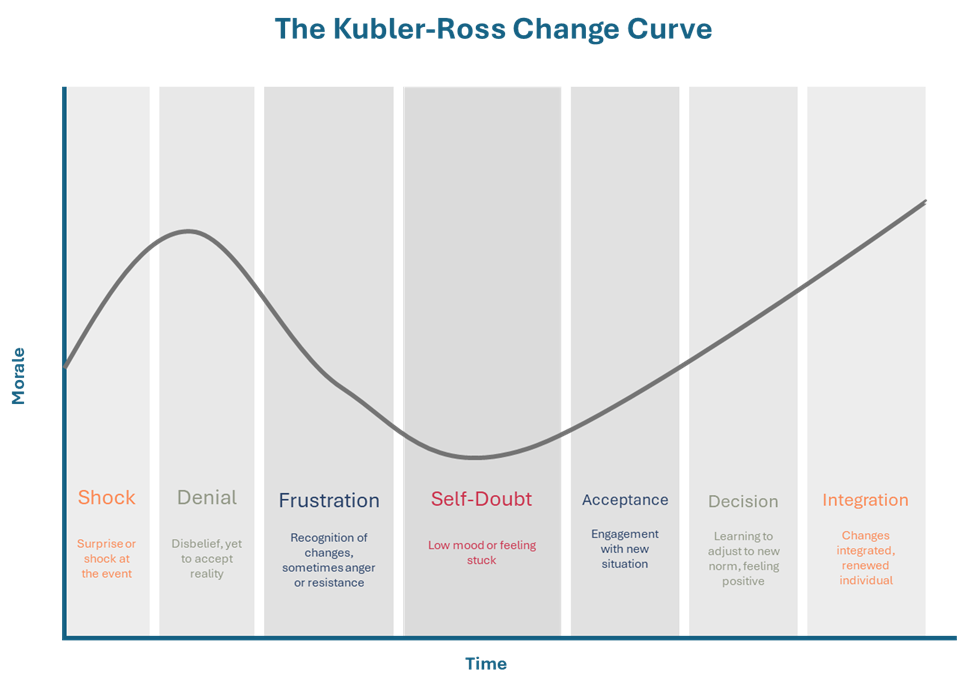
Understanding the Impact of Change and Organisational Restructure
Welcome to part one of our Leading Through Change series, where we delve into the multifaceted impact of organisational restructuring. From understanding the dynamics of change to guiding managers through difficult conversations about career transitions and redundancies, we explore how proactive leadership can support employees to navigate career shifts and foster a positive work culture.
In the ever-evolving landscape of today’s workforce, career transitions have become a common occurrence. Whether prompted by economic downturns, organisational restructuring, or personal growth aspirations, these transitions can have profound effects on both workplaces and workers alike. In this article, we’ll delve into the various facets of career transitions, exploring their impact on individuals and organisations, and highlighting the importance of providing compassionate leadership and support during these critical junctures.
Career Transitions: Self-directed vs. Involuntary
Career change is often inevitable. In fact, according to the Australian Bureau of Statistics (ABS), the Australian workforce is the most mobile it has ever been, with 9.5% of workers changing jobs within the 12-months before February 2023.[1] Further, Australian employment data collected in February 2023 revealed that over 56% of workers had been in their current role for less than five years and about 21% for less than 1 year.[2] These statistics underscore significant shifts in employment trends and the evolving perspectives on work across different generations. Nowadays, it’s estimated that individuals might embark on up to 12 different job roles and three career changes in their lifetime. [3] This trend is particularly pronounced among younger workers, marking a departure from the traditional model of a lifelong commitment to a single job or career.
Emerging trends such as the gig economy and portfolio careers are largely reflective of self-directed changes. Factors influencing such changes may include pay considerations, work-life balance, job satisfaction, or a desire to pursue new interests. Whilst self-directed job and career changes are often positive and can improve mental health and wellbeing, changes forced upon individuals can have the opposite effect.
Involuntary changes to employment, such as redundancy, are common in times of economic downturn. During these periods, organisational restructuring and downsizing becomes inevitable as businesses seek to streamline operations and cut costs. Unfortunately, these measures can leave a trail of uncertainty and anxiety in their wake, affecting both those directly impacted by job losses and those who remain within the organisation.
Good Work is Good for Mental Health
Work is not merely a means of earning a paycheck; often, it is intricately intertwined with a person’s identity. For many, their profession is a central aspect of how they define themselves and sometimes how they are perceived by others. Work can provide people an opportunity to develop, learn, and grow. Moreover, it can provide people with a sense of purpose and fulfilment as they contribute to something larger than themselves.[4] Whether it’s through meaningful projects, collaboration with colleagues, or opportunities for leadership, work can instil a sense of purpose and direction in a person’s life. Therefore, when this is under threat (whether perceived or real) it can take a toll on an individual’s wellbeing.
The Impact of Being Made Redundant
Big life events and change, such as being made redundant, can be a deeply unsettling experience and impact an individual’s sense of stability. Beyond the financial implications, redundancy can also erode an individual’s confidence and sense of self. Thus, whether expected or sudden, finding oneself without a job can trigger a range of emotions and exacerbate existing mental health conditions.
Often, individuals worry about conveying the news to their friends and family, and they may harbour concerns about the impact of redundancy on their future job prospects. Conversely, some individuals may view it as a positive change and a chance to embrace something new. As such, individual reactions to involuntary job loss will vary and often exist on a dynamic spectrum. Change models such as the Kubler-Ross Change curve can help conceptualise the fluctuation of emotional states over time (Figure 1).
However, by no means an exhaustive list, common reactions to job loss may be:
* Shock and a feeling of numbness
* Disbelief
* Anger
* Grief
* Guilt
* Overwhelm
Figure 1. Fluctuations of emotional state during times of change.

Organisational downsizing can inadvertently affect not only the employees who have been made redundant but also the workplace culture. Whilst not the primary focus of organisational restructuring, remaining employees sometimes experience ‘survivor syndrome’ (feelings akin to guilt, job insecurity, fear, or anger) which can significantly impact their morale and productivity.[1] As such, it’s important to consider their needs too.
Supporting Workers Through Redundancy
In times of career transition, providing support and guidance to impacted workers is crucial for their wellbeing and engagement. Organisations, and therefore leaders, have a responsibility to offer practical assistance and emotional support to employees. Moreover, fostering a culture of transparency and open communication can help build trust among colleagues and becomes a protective factor in managing psychosocial hazards at work. By keeping workers informed about the reasons behind organisational changes and providing resources and support tools, employers can mitigate the negative impact of redundancies and create a more supportive and resilient workplace environment.
In the next instalment of this series, we break down the process of having a difficult conversation about career transitions and redundancies.
Sources:
[1] Petzer, M. (2018, December). Sinking ship syndrome. The Chartered Institute of Personnel and Development. https://www.cipd.org/en/views-and-insights/thought-leadership/the-world-of-work/sinking-ships-syndrome-redundancies/
[1] Australian Bureau of Statistics. (2023, June). Job mobility. https://www.abs.gov.au/statistics/labour/jobs/job-mobility/latest-release
[2] Australian Bureau of Statistics. (2023, June). Job mobility. https://www.abs.gov.au/statistics/labour/jobs/job-mobility/latest-release
[3] Broom, D. (2023, May 2). Having many careers will be the norm, experts say. World Economic Forum. https://www.weforum.org/agenda/2023/05/workers-multiple-careers-jobs-skills/
[4] Mentally Healthy Workplaces. (n.d.). Creating an environment that supports thriving. https://beta.mentallyhealthyworkplaces.gov.au/explore-modules/foundations-mentally-healthy-workplace/creating-environment-supports-thriving

